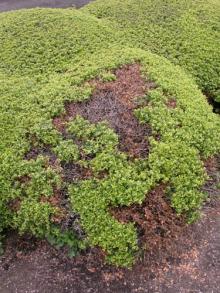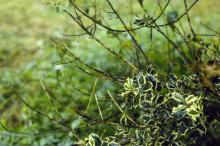Cause Phytophthora ilicis, a fungus-like microorganism. The disease develops in cool, rainy weather of fall and winter and subsides in warm, dry summer months. It may be very severe in dense orchards where air circulation is poor. In some orchards on the Oregon coast, the disease has caused almost complete defoliation and severe twig blighting, particularly on lower limbs.
The fungus-like microorganism produces oospores in leaf spots and the cortex of dead twigs. These spores allow the microorganism to survive from one season to the next. Pruning wounds and spine punctures, created by wind-whipped leaves, are ideal areas for new infections. Leaf scars can also be infected by zoospores or sporangia. Defoliation is related to the infected plant tissue's production of ethylene.
All cultivars of Ilex aquifolium appear to be susceptible. Many other species appear to be resistant to both infection and defoliation including I. cassine, I. ciliospinosa, I. cornuta, I. crenatas, I. glabra, I. intricata, I. latifolia, I. perado, I. sugeroki, I. vomitoria. Some interspecific hybrids had low amounts of infection and defoliation.
Symptoms The disease is characterized by purple-black leaf spotting, defoliation, and the development of twig cankers. Leaf spotting frequently begins on the leaf margin and on the lower part of the trees in late fall. The disease progresses up the tree during winter. Twigs die back, and cankers develop on larger stems later in winter. Infection may be at a berry cluster, and may girdle and kill the twig. Young plants in nursery beds also are affected and may be defoliated and killed.
Cultural control
- Control weeds and brambles to help air circulation.
- Select a site that permits good air drainage.
- Space and prune trees to permit good air circulation.
- Remove and destroy fallen leaves and dead infected twigs during the summer.
- Plant resistant cultivars.
- Prevent potted plants in nurseries from falling over allowing foliage to touch the ground.
- The use of ethylene blockers (such as EthylBloc) before shipping may be helpful.
Chemical control Make the first application before fall rains begin. Additional applications after harvest or severe winter storms may be useful. Rotate and/or tank-mix fungicides from different groups that have different modes of action for resistance management.
- Aliette at 6 to 12 oz/100 gal water is registered for use as a drench on Japanese holly (Ilex crenata). Foliar applications would be more effective. Do not use with, or soon before, or after applications of copper-based products. Try on a few plants first before widespread use. Do not use with adjuvants. Group P7 fungicide. 24-hr reentry.
- Broadform at 2 to 4 fl oz/100 gal water. Group 7 + 11 fungicide. 12-hr reentry.
- CuPRO 5000 at 1.5 to 5 lb/A. Group M1 fungicide. 48-hr reentry.
- Daconil Weather Stik at 1.38 pints/100 gal water is registered for holly, but this specific disease is not on the label. However, the chemical is effective as a protectant for other, similar diseases. Group M5 fungicide. 12-hr reentry.
- Fosphite at 1 to 2 quarts/100 gal water. Do not use copper products within 20 days of treatment and do not use spray adjuvants. Group P7 fungicide. 4-hr reentry.
- Heritage at 1 to 4 oz/100 gal water plus a non-silicone-based wetter sticker. Group 11 fungicide. 4-hr reentry.
- Mancozeb-based products are effective only before symptoms occur. A good broad-spectrum mixing partner with other fungicides. Group M3 fungicides. 24-hr reentry.
- Fore 80 WP at 1.5 lb/100 gal water plus a spreader-sticker.
- Protect DF at 1 to 2 lb/100 gal water plus 2 to 4 oz spreader-sticker.
- Mefenoxam 2 AQ at 0.49 to 1.96 fl oz/100 gal water as a foliar spray. Fungi resistant to the active ingredient can build up quickly; therefore, always tank-mix with another fungicide. Group 4 fungicide. 48-hr reentry.
- Micora at 4 to 8 fl oz/100 gal water. Group 40 fungicide. 4-hr reentry.
- Subdue MAXX at 0.5 to 1 fl oz/100 gal water plus another fungicide. Fungi resistant to the active ingredient can build up quickly; therefore, always tank-mix with another fungicide. Group 4 fungicide. 48-hr reentry.
- Zonix at 45 to 76 fl oz/100 gal water. Short residual so may have to be used frequently for adequate results. 4-hr reentry.
Note Fixed copper as a preventive postharvest soak (dip tanks with a copper concentration of 30 ppm) was used last century but there are no current copper labels that support this use. Cuttings were soaked promptly after harvest, and tank water was changed frequently.
Reference Buddenhagen, I.W. and Young, R.A. 1957. A leaf and twig disease of English holly caused by Phytophthora ilicis N. sp. Phytopathology 47:95-101.





